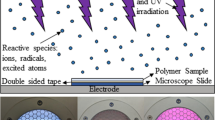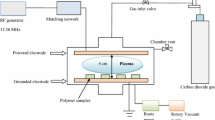Abstract
Polyurethane membranes were prepared under nitrogen atmosphere by using various proportions of toluene diisocyanates (TDI) and polypropylene-ethylene glycol (P) with addition of no other ingredients such as catalysts, initiator or solvent in order to achieve medical purity. Effects of composition on mechanical properties were examined. In general, modulus and UTS values demonstrated an increase and PSBR demonstrated a decrease as the TDI/Polyol ratio of the polymer increased. Elastic modulus, ultimate tensile strength (UTS) and per cent strain before rupture (PSBR) values were found to be in the range of 1.4–5.4 MPa, 0.9–1.9 MPa, and 60.4–99.7%, respectively. Surfaces of the membranes were modified by oxygen plasma applying glow-discharge technique and the effect of applied plasma power (10 W or 100 W, 15 min) on surface hydrophilicity and on the attachment of Vero cells were studied. Water contact angle values of the plasma modified surfaces varied between 67° and 46°, demonstrating a decrease as the applied plasma power was increased. The unmodified material had 42–45 cells attached per cm2. It was observed that as the applied power increased the number of attached cells first increased (60–70 cells/cm2 at 10 W) and then decreased (27–40 cells/cm2 at 100 W). These demonstrated that surface properties of polyurethanes can be modified by plasma-glow discharge technique to achieve the optimum levels of cell attachment.
Similar content being viewed by others
References
G. L. Wilkes, T. S. Dziemianowica, Z. H. Ophir and E. J. Artz, Biomed. Mater. Res. 13 (1979) 189.
A. Burke, V. N. Hasirci and N. Hasirci, J. Bioact. Comp. Poly. 3 (1988) 232.
J. S. Colligon, A. Dekker, A. Curry and C. J. Kirkpatrick, J. Mater. Sci. Mat. Med. 7 (1996) 119.
J. Y. Zhang, E. J. Beckman, N. P. Piesco and S. Agarwal, Biomaterials 21 (2000) 1247.
E. J. Kim, I. K. Kang, M. K. Jang and Y. B. Park, ibid. 19 (1998) 239.
N. Kayirhan, A. Denizli and N. Hasirci, J. App. Poly. Sci. 81 (2001) 1322.
K. Ulubayram and N. Hasirci, J. Colloids and Surfaces, Biointeractions 1 (1993) 261.
N. Hasirci, J. App. Poly. Sci. 34 (1987) 2457.
H. Yasuda and M. Gazicki, Biomaterials 3 (1982) 68.
S. Desai, I. M. Thakore, B. D. Sarawade and S. Dewi, Eur. Poly. J. 36 (2000) 711.
J. S. Bae, E. J. Seo and I. K. Kang, Biomaterials 20 (1999) 529.
N. Hasirci, J. App. Poly. Sci. 34 (1987) 1135.
X. Ramis, A. Cadenato, J. M. Morancho and J. M. Salla, Polymer 42 (2001) 9469.
C. Zhou and Z. Yi, Biomaterials 20 (1999) 2093.
S. Kutay, T. Tincer and N. Hasirci, Brit. Poly. J. 23 (1990) 267.
A. Takahara, A. Z. Okkema and S. L. Cooper, Biomaterials 12 (1991) 324.
N. K. Eib and K. L. Mittali, J. App. Poly. Sci. 25 (1980) 2435.
Author information
Authors and Affiliations
Rights and permissions
About this article
Cite this article
Ozdemir, Y., Hasirci, N. & Serbetci, K. Oxygen plasma modification of polyurethane membranes. Journal of Materials Science: Materials in Medicine 13, 1147–1152 (2002). https://doi.org/10.1023/A:1021185803716
Issue Date:
DOI: https://doi.org/10.1023/A:1021185803716




